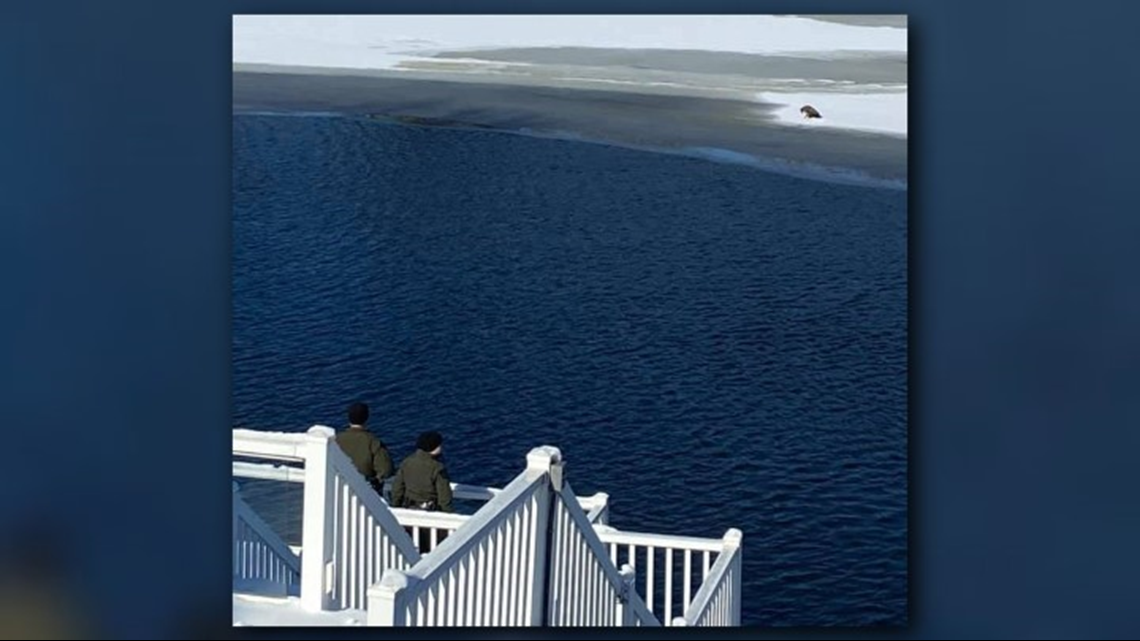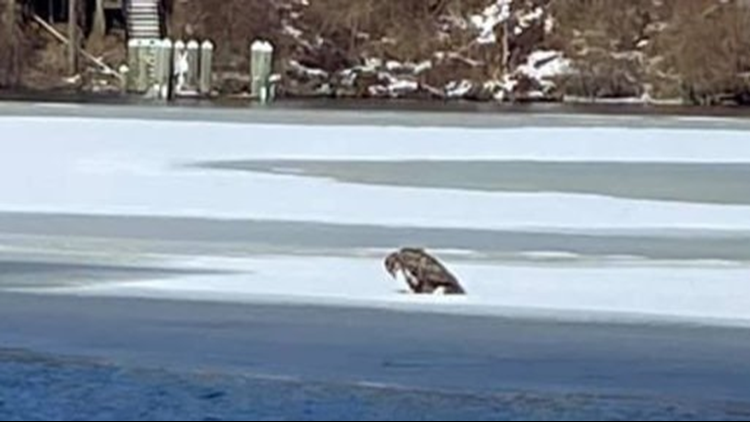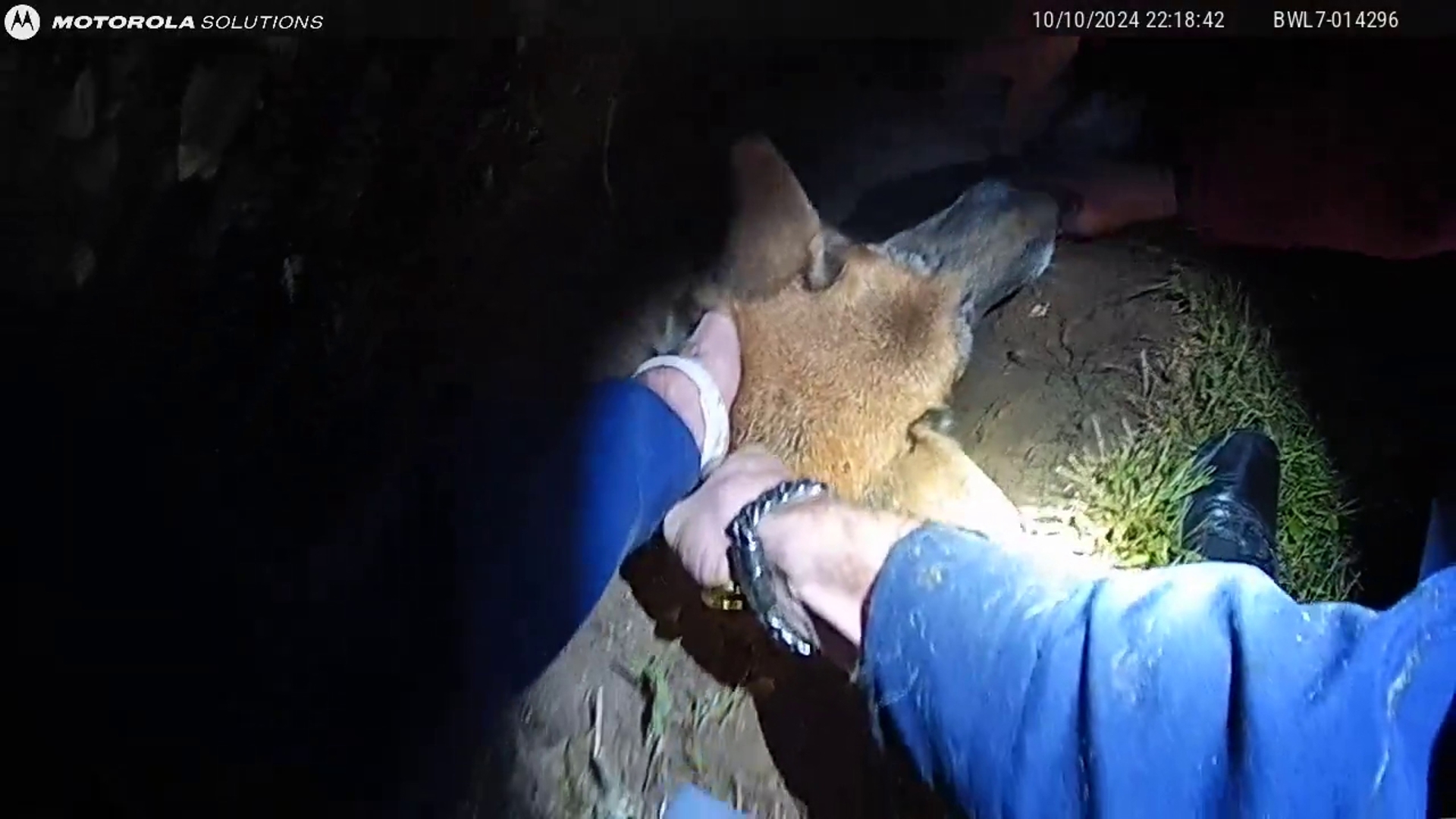SPRING LAKE, Mich. — (Grand Haven Tribune) Two bald eagles were swooping in a manner different than what Diane Valk was used to seeing, but the Spring Lake resident thought there was a small animal on the ice that was attracting their attention Sunday morning.
A few hours later, before leaving her house, Valk decided to take a look, walked out on her dock and realized there was an immature eagle apparently injured or stuck in the ice.
“I was shook up,” she said. “All I could think of that it was going to lay down and die.”
Valk said she saw the eagle lift its head and put it back down on the ice.
“I’m a cat rescuer, so I’m always on the lookout for hurt animals,” she said, then admitted she was not used to dealing with wild animals.
The Baird Point resident took her dog outside in an effort to scare the eagle, but it did not move.
She said she didn’t know what to do so she went to social media – first to her animal rescue groups and then to some of the Facebook informed groups.


Within an hour of that 1 p.m. plea, Valk said her driveway was full of vehicles from people responding to her request.
“It’s so impressive that a community like this will help a bird in need,” she said. “These people, on a Sunday, stopped everything they were doing to help out. I put my plea out and it was incredible.”
Carl Johnson of Great Lakes Nuisance Animal Control was one of the ones on the scene. Because the situation involved a federally protected bird, he contacted the local conservation officers from the Michigan Department of Natural Resources.
Also responding were Spring Lake firefighters.
Fire Chief Brian Sipe said neighbors supplied kayaks and the conservation officers were preparing to launch when the eagle was able to stand up, start walking and eventually fly away.


Firefighters were also responding with ice rescue suits in case the conservation officers needed some help from the water.
“They think it dove down to get a fish, went up on the ice and its wings froze to the ice,” Johnson said. “The homeowner said it had been there for several hours.”
But when things warmed up, and with the commotion from all of the people, the eagle flew away.
“A lot of time nature takes care of itself,” Johnson said.
But it was the right thing to do to call for help, he added.
Conservation Officer Jackie Miskovich said they believed, because the eagle was young, that its depth perception might not have been totally developed and the bird might have hit the ice shelf on the dive down to get a fish.
“It was probably stunned,” she said, although it was also possible the wings full of water had frozen to the ice.
When the conservation officers arrived, the eagle’s legs were visible through binoculars. If it was frozen to the ice, that would not have been the case, she said.
What you should do
When you see something like this, keep track of how long the bird or animal is there and be mindful of weather conditions, Johnson said. If it’s an eagle, call the DNR or someone like himself.
Miskovich agreed.
“Safety is our biggest concern,” she said. “If you see an injured eagle, don’t touch it. Wait until we get there. Eagles have long necks and they do peck. Their talons are very strong.”
Once the conservation officers assess the situation, they may ask for your help.
Anyone who suspects an eagle is injured should call or text the DNR’s Report All Poaching (RAP) line at 800-292-7800. There is also an online reporting form.
The eagle is a priority species for conservation officers and the DNR, Miskovich said. The RAP line is monitored 24 hours a day, seven days a week and an officer will be dispatched.
Johnson said it was fortunate the eagle was able to take off on its own.
He commended all of the people who were concerned and showed up to help.
“It was a happy ending,” Valk said.
More stories on 13 ON YOUR SIDE:
RELATED VIDEO:
►Make it easy to keep up to date with more stories like this. Download the 13 ON YOUR SIDE app now.
Have a news tip? Email news@13onyourside.com, visit our Facebook page or Twitter. Subscribe to our YouTube channel.




